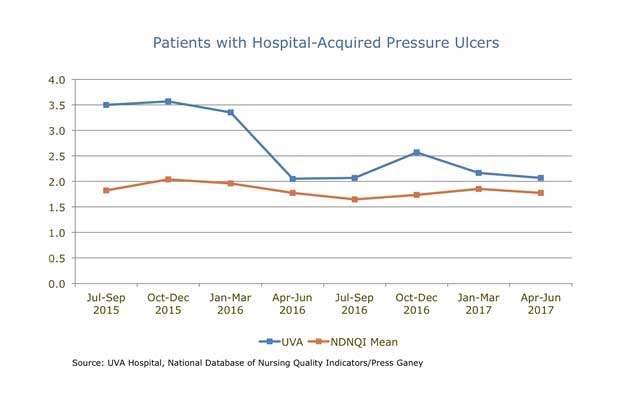

This decision support approach reduced the prevalence of HAPU tenfold and the ICU length of stay by about one-third. Attitudes toward PU Manager were positive. Data entry regarding ulcer severity and body site increased, and the participants used PU Manager more than once a day for over 80% of eligible cases. After adjustment for primary diagnoses and illness severity, the intervention group was significantly less likely than the baseline group to develop HAPU and had a shorter ICU length of stay (OR=0.67, p<0.0001). In the intervention group, the overall HAPU prevalence rate fell from 21% to 4.0% and the ICU length of stay shortened from 7.6 to 5.2 days. The intervention group included 866 at-risk patients in the surgical ICUs of a tertiary teaching hospital over a 6-month period in 20 the controls were 348 patients from a 6-month baseline period in 20. We used a Bayesian Network model that was validated in previous studies and linked to the electronic health record system in an application called Pressure Ulcer (PU) Manager. We compared the HAPU prevalence before and after introducing the intervention, and surveyed the users. To develop and assess the impact of a decision support intervention to predict HAPU on the prevalence of ulcers and length of stay in an intensive care unit (ICU), and on the user adoption rate and attitudes. The nurse manager also reiterated the importance of turning patients on medical devices, such as extracorporeal membrane oxygenation (ECMO) machines, and inspecting their skin.Hospital-acquired pressure ulcers (HAPU) are common among inpatients and create substantial morbidity, mortality, and costs, but prevention strategies have been only variably effective. For example, a representative from a healthcare equipment vendor re-educated nurses on using the Turn & Position System (TAP) to assist with repositioning critically ill patients.
#Ways to help prevent hapu skin
The CT utilizes a checklist to note the position of the patient (left, right, back) upon entry into the room, repositioning of the patient and examination of areas at high risk for skin breakdown.ĭuring daily huddles, the nurses discuss the turn team’s activities, report on any HAPUs and provide education. The turn team comprises four clinical technicians who each round on six beds and help the nurses turn the patient, review supplies available in the room (such as boots and wedges) and order missing supplies. But drinking too much alcohol can raise blood pressure by several points. One drink equals 12 ounces of beer, 5 ounces of wine or 1.5 ounces of 80-proof liquor. To solve this primary issue, the coronary ICU implemented a turn team in January 2019. Limiting alcohol to less than one drink a day for women or two drinks a day for men can help lower blood pressure by about 4 mm Hg. Clinical technicians (CTs) were often tied up with jobs such as patient care, stocking supplies and transport. “One of the biggest issues cited by nurses was delays in turning patients because they couldn’t find someone to help,” says Flowers-Surovi. For instance, the diagram noted that a patient’s hemodynamic instability and size/weight contribute to HAPUs, as do malfunctioning beds and delays in getting supplies from the storeroom. To help identify the root cause of HAPUs, the nurses created a fishbone diagram that outlined 15 factors falling into six main areas: environment, materials, patient, processes, equipment and caregivers. “It was a group effort with our nurse manager, assistant nurse manager, clinical nurses and clinical technicians on the unit,” says Rimelspach. “The benefits of decreased HAPU rates are so important, not only for the patient, but for the hospital system as well.” Investigating the root causesĪ team of nurses including Flowers-Surovi and Mary Rimelspach, BSN, RN, began brainstorming solutions, informally interviewing nurses on the coronary ICU and discussing ideas at shared governance meetings.

“HAPUs have such an impact on the patient’s length of stay, and they can lead to other issues and increase costs for the hospital,” says Amy Flowers-Surovi, BSN, RN, CCRN, a clinical nurse in the coronary ICU. We do not endorse non-Cleveland Clinic products or services Policy The following CQO leading practice describes collaboration between Supply Chain, Value Analysis and Nursing Leads to reduce Hospital Acquired Pressure. Advertising on our site helps support our mission.

Care plans should acknowledge the need for patients to shift their weight a little each time you enter the room (at least 15 to 20 degrees if possible). Cleveland Clinic is a non-profit academic medical center. Frequent small repositioning shifts can help prevent pressure ulcers.


 0 kommentar(er)
0 kommentar(er)
